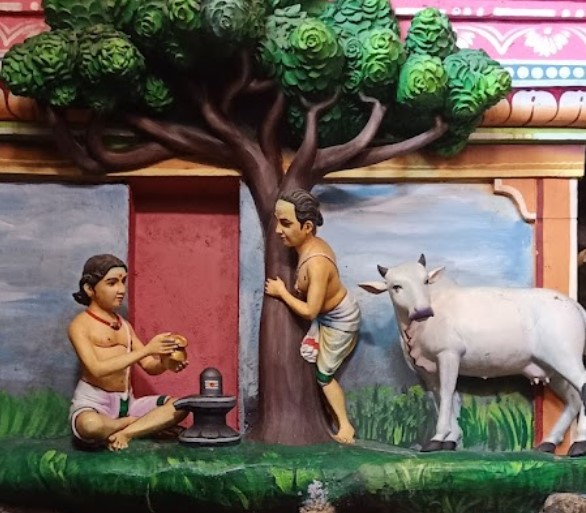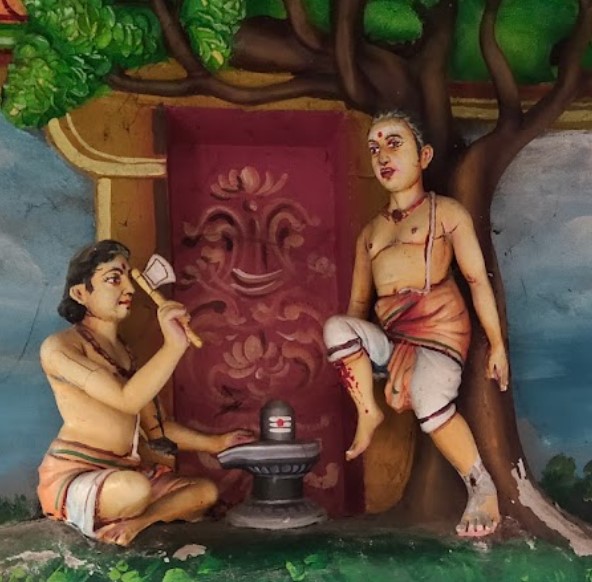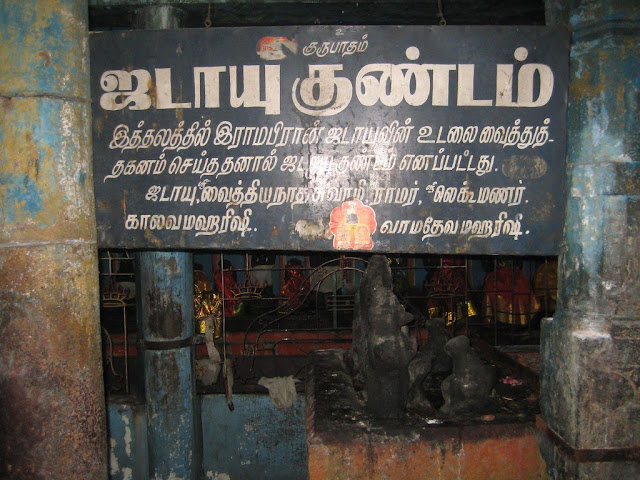- Vaidyanatha Swami Temple is a Hindu Temple dedicated to Lord Shiva located in Vaitheeswaran Koil near Sirkazhi in Nagapattinam District of Tamil Nadu.
- The beautiful environs of the temple is nestled between Sirkazhi and Myladuthurai in Nagapattinam district of Tamil Nadu.
- Vaidyanatha Swami Temple is also called as Pullirukkuvelur.
- The Presiding Deity is called Vaitheeswaran / Vaidyanathar and Mother is called Thaiyalnayaki.
- Lord Vaidyanatha and Thaiyal Nayagi are the family God (Kula Dheivam) for the Kshatriya Community (Vanniyakula Kshatriyas) of South India.
- This shrine is known under several names like Lalayapuri, Vedapuri, Panarapuri, Pathiripuri, Angarakapuram and Ambikapuram.
- The village is also known for palm leaf astrology called Nadi astrology in Tamil.
- The Veera Raghava Swamy Temple at Thiruvallur is considered as the Vaishnavite temple equivalent of healing abilities of the presiding deity to that of the Saivite Vaitheeswaran Kovil.
- The holy waters of the Siddhamirtham tank within the temple complex contains nectar, and a holy dip is believed to cure all diseases.
- The temple is revered by the Devaram hymns of 7th Century Saiva Nayanmars -Tamil saint poets and is also classified as a Padal Petra Sthalam (temple revered by the Nayanmars).
- Appar and Sambandar had sung hymns in praise of Lord Shiva of this Temple.
- This is the 70th Devaram Padal Petra ShivaSthalam and 16th Sthalam on the Northside of River Cauvery inChozha Naadu. Lord Muruga of this Temple had been praised by Saint Arunagirinathar in his Thirupugazh Hymns.
- When one steps into the Vaitheeswaran Temple one gets the feeling of stepping into a divine world built centuries ago. The calm environs of this temple heals both body and mind of devotees.
- This temple is popularly known as Vaitheeswaran Koil and it stands as a revered sanctuary. The beautiful environs of the temple is nestled between Sirkazhi and Myladuthurai in Nagapattinam district of Tamil Nadu.
- Built almost 1000 years ago, this ancient Hindu temple, dedicated to Lord Vaidyanathar (Lord of Healing and Divine Physician) and His Consort Thaiyal Nayagi (The Mother who can sew up wounds), holds a unique place in our collective spiritual landscape.
- The temple also is famous for Lord Muruga who is named as Selva Muthukumaran and is also one of the Navagraha Temples for Mars (Angarakya)
- The temple is majestic and has other shrines for Muruga, Vinayaka, Balambal and Shiva lingam.
- This temple features bronze statues of Nataraja, Angaraka, Jatayu and others.
- With a history steeped in folklore and a reputation as a centre for healing, this sacred place draws devotees from all corners of India and even the world. Here we embark on a journey to explore the rich tapestry of Vaitheeswaran Koil, uncovering its history, spiritual significance, healing traditions, and architectural marvels.
- In one of the mythological tales it is mentioned that it was at this very location that Lord Rama, the seventh avatar of Lord Vishnu, performed the last rites of Jatayu, the noble vulture who valiantly fought to rescue Sita from the clutches of Ravana.
- This sacred act by Lord Rama sanctified the land and made it a focal point for spiritual seekers.
CONSTRUCTION:
- The Temple received royal patronage from various rulers of ancient Tamil Nadu like Kulothunga Chola, Vikrama Chola, Vira Rajendra Pandya, Achuthappa Nayak (1560 - 1614 AD) and Maratha prince Thulaja.
- The temple is maintained by Dharmapuram Aadheenam, a Saivite mutt or monastic institution located in the town of Mayiladuthurai, India.
- As of 1987, there were a total of 27 Shiva temples under the control of the Aadheenam.
PURANIC SIGNIFICANCE:


Pullirukkuvelur :
The place is also known as Pullirukkuvelur. Pul means Bird-here the eagle king Jatayu, the noblest character in Ramayana in the service of Lord Sri Rama, Irukku the Rig Veda, Vel-Lord Muruga and Oor the place make the name Pul Irukku Vel Oor = Pullirukkuvelur.
Angarakan, Son of Lord Shiva:
As per local legend, Shiva was doing penance at mount Meru when a drop of water fell from his forehead which turned into a beautiful child. Bhoodevi brought up the child, who went on to become a staunch devotee of Shiva. Pleased by the devotion, Shiva turned him to a planet. Based on his colour, Angarakan (Mars) is usually clad with red coloured cloth.
Navagraha Temple:
One of the nine planets, Angarakan (Mars), suffered from leprosy and was cured by Vaidyanatha Swamy and from then on it is treated as one of the Navagraha Temples for planet Angarakan. Angarakan was cured of his leprosy after a dip in the holy water here.
Veerasenan Son was cured of Tuberculosis here:
A king, Veerasenan by name came here with his son suffering from tuberculosis, bathed in the Theertha and offered sweet nivedhanas. He consumed the nivedhana with his son. His son was cured completely.
Chella Muthukumaraswami:
As a beloved son of Lord Vaidyanatha and Mother Thaiyal Nayaki, Lord Muruga in the temple is praised as Chella Muthukumaraswami – Chella-beloved. Lord Muruga enjoys all prominence in the temple. Hence all festivals are dedicated to him. Pujas to Lord and Mother are offered only after pujas to Lord Muruga.
Lord Shiva cured Tirunavukkarasar’s Stomach pain here:
Tirunavukkarasar was suffering from severe stomach pain. At times, his sister told him to pray to Lord Vaidyanatha Swamy. Then he prayed and got cured by Lord Shiva. He also became a great devotee of Lord Shiva and sung many songs for Lord Shiva.
Daksha had his head and body joined together here:
Daksha had his head and body joined together after Siva punished him for his disrespect after taking bath in the Temple tank.
Jatayu Kundam:

Jatayu, the eagle king, engaged in the service of Lord Rama was killed when he prevented Ravana from abducting Mother Sita. As requested by him, Sri Rama performed the last rites for the bird in the Vibuthi Gundam here. There are niches of Rama, Lakshmana and Vishwamitra, Vasishtha and Jatayu near the Theertham.
Lord Muruga got his Vel weapon here:
Parvati, the consort of Shiva, asked her son, Subramanya to appear with one face from his regular appearance of six faces. When he did so, she was pleased and presented him with vel (a weapon) to slay the demons. Subramanya overcame the asura Surapadman (a demon) and in the war, his army was severely injured. Shiva came out as the healer Vaitheeswaran and cured the wounds. Before waging war against the demon Padmasura, Lord Subramanya was blessed by Lord Shiva and goddess Parvathi here by offering a bouquet and this festival is being celebrated every year in the name Skanda Sashti.
People worshipped Lord Shiva here:
Rama, Lakshmana, Hanuman and Sapta Rishis (Seven important saints) have worshipped the deity in this place during Ramayana period. Also, Suryan, Sambathi, Brahma, Saraswathi, Durga, Parasarar, Durvasa and Siva Sharma worshipped Lord Shiva here.
d66f6e.jpg)